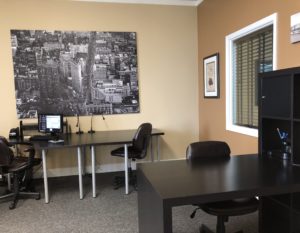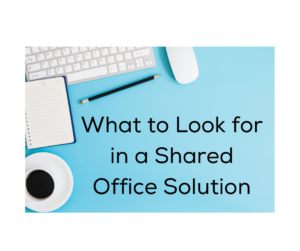Transforming Law Practices: The Benefits of Shared Office Spaces for Law Firms
As the legal landscape evolves, law firms constantly seek new ways to optimize their practices, increase efficiency, and reduce costs. One solution gaining popularity is shared office spaces. This blog will explore the numerous benefits of shared office spaces for law firms and how they can contribute to your firm’s success.
Cost Savings
Shared office spaces offer law firms a more cost-effective alternative to traditional offices. By sharing the area and its associated costs, such as rent, utilities, and maintenance, firms can save considerable money. This allows them to allocate resources to more pressing needs, such as hiring additional staff or investing in new technology.
Flexible Lease Terms
Many shared office spaces offer flexible lease terms, allowing law firms to adjust their tenancy according to their needs. This flexibility is particularly beneficial for growing firms or those experiencing fluctuations in their caseloads, as they can easily scale their office space up or down as required.
Networking Opportunities
Shared office spaces often house professionals from various industries, creating a rich networking environment. Law firms can benefit from this by establishing connections with other businesses and fostering relationships that may lead to referrals, collaborations, or even new clients.
Access to State-of-the-Art Facilities
Most shared office spaces provide access to well-equipped meeting rooms, conference facilities, and state-of-the-art technology. This enables law firms to make a professional impression on clients and other legal professionals without incurring the costs of maintaining such facilities in a private office.
Enhanced Productivity
The communal environment of shared law office spaces can positively impact productivity. By working alongside other professionals, law firm employees may feel more motivated and inspired to perform at their best. Additionally, many shared office spaces offer a variety of workspaces, from private offices to open-plan areas, allowing individuals to choose the environment best suited to their work style.
Streamlined Administrative Services
Shared office spaces often provide various administrative services, such as receptionists, mail handling, and phone answering. This allows law firms to focus on their core legal work without hiring additional administrative staff or managing these tasks themselves.
Collaborative Atmosphere
A shared law office space fosters a collaborative atmosphere where professionals can exchange ideas, share knowledge, and learn from one another. This can lead to innovative solutions and creative problem-solving for law firms, giving them a competitive edge in the legal industry.
By embracing this new way of working, law firms can optimize their practices, enhance productivity, and stay competitive in the ever-changing legal landscape. Work Webb, located in Daytona Beach, Florida, offers law office share services. Visit our website to learn more, and call us to schedule a tour. We have a wide selection of options to fit most legal office needs.
Build Strong Relationships with your Remote Team
Remote employees are mentally and physically happier, which is part of the new normal. It gives employers more hiring options, and a company will have productive and satisfied staff if done correctly. For example, research from Owl Labs found that remote and hybrid employees were 22% happier than workers in an onsite office environment and stayed in their jobs longer.
However, there are still challenges when it comes to remote workers, and it can be challenging to maintain consistent communication with your team to combat the increased feelings of loneliness and isolation. Therefore, staying productive and boosting morale is essential to building strong work relationships.
Whether your team is entirely virtual or hybrid, and you want to build strong relationships with your team, staying connected is critical. These strategies will help.
Schedule virtual breaks
Employees working remotely still need breaks during the day. Let people know when you take your coffee break, and invite them to join you. Keep your virtual coffee break between 10 and 15 minutes and use small-group features like breakout rooms to encourage more discussion.
Create moments of connection
Before each work meeting, take a moment to check in with each employee. This practice became a routine during the pandemic and continuing to ask personal questions such as “How are you doing ?” can help build the healthy connections needed to combat feelings of isolation.
Leverage visual collaboration software
Encouraging collaboration in the workplace is shown to increase productivity. According to a Stanford study, people who are encouraged to collaborate stick to a given task 64% longer than people who work alone. In addition, those same workers report higher engagement levels, less fatigue, and higher success rates. Visual collaboration software offers features that can imitate those used when working together in person. Collaboration can be achieved with technology, and every employee can contribute regardless of location.
Be proactive with status updates
You don’t want to be out of sight, out of mind when working remotely. Instead, take a proactive approach to schedule time with your manager—even if it’s just a 15- or 30-minute weekly call to check in.
Adapting to the new world of work can be challenging in many ways. But you can build strong relationships within your organization with a bit of ingenuity.
How to Create Better Work Experiences
The pandemic has transformed how we work and our expectations about work. There is a new awareness of how we work best— individually and collectively. This awareness is shaping new expectations about the physical workplace and how we manage its spaces. In addition, the new post-pandemic workplace must provide better work experiences and this means options.
Create places to work, reflect, and socialize in your office.
Rethink breakrooms and lobbies as places where employees can go to collaborate and even take a break from the screen. Telling your staff that they can take a break when needed and having space to do that will make them feel better about taking breaks when needed.
Revamp the Work Schedule.
Working from home is not for everyone, and by now, you can probably identify the workers that thrive in this setting and who do not. By revamping the work schedule to fit the individual needs of your staff, you will keep productivity and mental health positive. Hybrid is here to stay as well, so find a coworking space that has an option that fits your budget and schedule so your employees can work on their schedule when needed.
Being with other people is now an amenity.
As will all amenities, not everyone needs them to be productive. Coffee stations are critical to some employees, but not all. The same can be said for being with other people for work. With hybrid schedules, work from home, or a shared office solution, you can offer options to your staff to provide a better work experience where they individually thrive.
Post-pandemic is an excellent opportunity to create a new people-focused work experience that builds relationships and trust, fosters well-being, and promotes inclusion and equity. So hold a meeting with your team to get honest feedback on improving the work experience.
Hybrid vs. Remote: Which is Better for You?
The work landscape has changed in the past two years and many employees are considering hybrid vs. remote work schedules. The 9-to-5 workday is so last century. In today’s 24/7 global economy, employers and employees enjoy the benefits of more flexible work arrangements. There are two primary types of flexible work arrangements: hybrid and remote. A hybrid schedule is a mix of in-office and at-home work, while a remote schedule is 100 percent at-home.
But how do you determine which is the right one for you? Here are some questions to ask if you are considering a hybrid vs. remote work schedule yourself to determine which will work for your individual needs.
Is an office required for your career?
This should be the first question you ask yourself, “Can I do my job the same from home, or do I have to go into an office to be productive.” Some industries, like manufacturing, where employees must be centrally located to get the job done. But what COIVD taught us is there are more industries than we imagined that could go remote or hybrid. So, for example, who would have thought telehealth would ever be a thing? Because how can you practice medicine without physically seeing the patient? Easily apparently with the assistance of technology but not for all health issues.
Doing some soul searching and researching to see if your career can go remote or hybrid for the long term will help you determine your best choice.
How do I work best?
Once you have determined if your industry can work remotely, you need to be honest with the type of worker you are at your job. Regarding a hybrid vs. remote work schedule, do you need watercooler banter to be happy and productive? Or can you work remotely without this type of in-person interaction? Again, COVID taught many of us that we are more social than we may have thought, and this social interaction with coworkers was an important part of our work life. This is why it is essential to ask this question when determining if a remote or hybrid schedule is right for you.
Am I disciplined enough to work remotely?
Remote workers need to stay focused and adhere to a schedule without coworkers, or supervisors, around to monitor them. Be honest with yourself on this question because with the flexibility of a remote schedule comes the responsibility of being self-motivating and productive. A hybrid schedule might be a better option if you fear you lack the dedication to work remotely 100% of the time.
Whether you choose a remote or hybrid work schedule, a shared office solution like Work Webb can assist when needed, no matter which schedule works for you. Whether it is a desk for a day, a conference room rental, or a work address for mail, we have options to meet most needs for both remote and hybrid workers. Visit our website to see what our happy clients say about our services and call us to schedule a tour.
Coworking Spaces Can Make Employees Happier
A 2019 survey by Gartner revealed that just 13% of employees are satisfied at work. Fortunately, a 2022 survey by Willis Towers Watson found that 90% of employers plan to put employee experience at the top of their agenda.
If you’re a business owner thinking about renting desks for your team, here are two reasons you should consider a coworking space membership without delay.
A sense of belonging
Our sense of belonging is vital for our well-being. These groups could be our peers, sports teams, religious groups, or coworkers. The latter is essential when it comes to the employee experience, and it’s something you don’t get proper when you work from home every day.
Belonging is about more than holding Zoom meetings.
A coworking space is where remote employees can visit to reconnect with colleagues after periods of working from home. It also allows employees to build relationships and social groups with other people who use the space.
Coworking spaces can improve people’s well-being
Our work lives can significantly impact our sense of well-being, which is why it’s so crucial for employers to create workplace environments that prioritize well-being and work-life balance.
Employers need to be flexible to achieve a work-life balance, and coworking spaces can meet this need. For example, employers can pay for only the desks they need at any time accommodating a hybrid working schedule. Options tend to be super flexible, and companies can take on more or less space when needed.
Spacious breakout areas, adaptable desks, and areas that cater to different working styles can help maintain a high level of productivity.
If you are looking for a shared office solution for your coworking needs consider Work Webb. We have two locations and a variety of options to choose from. Call us to schedule a tour and read what our happy clients have to say about our services.
Organize your Work Environment for Improved Productivity
How you organize your work environment affects how your team behaves in that space, so strategically managing your office will help you create the company culture your team needs to hit their goals. Having a cluttered desk is not a sight that inspires one to have a productive day, much like waking up to a dirty kitchen. The appearance of clutter signals to your brain that there’s extra work to do before you can even start your daily tasks. When your brain feels overwhelmed by all this work, it triggers a stress response. Organizing your workspace reduces the frequency of that stress response, gives you a feeling of control and makes you more efficient.
You can take some easy organizational steps to quickly get ready for your day and not take up valuable work time.
Hide the Wires

Let’s face it; the wires can get out of control with all of the monitors, computer towers, mice, laptops, phones, and chargers that adorn the typical office desk. Because reducing visual clutter helps minimize stress, hiding all these messy wires is essential. Roll up the slack in each cord and slap on a binder clip. This tip will quickly organize the cord maze under your desk.
Use Wall Space to Your Advantage

Do you have free wall space near your desk? Don’t waste this valuable real estate. Instead, free up space on your desk by installing pegboards or wall shelves to sort mail, electronics, or office supplies. These times will still be handy and out of your way.
Organize your In-box

Email consumes a lot of our time and can get overwhelming quickly. Think of your email as your digital desk and keep it organized as your physical workspace. Create folders in your email to sort your emails into easily digestible information like to-do lists and even prioritize them. Taking the time to unsubscribe to various marketing emails like newsletters that you no longer want to receive will also be a worthwhile spend of your time instead of deleting them because this will ultimately reduce the number of emails you have to deal with daily.
Declutter

First, look at your desk and throw away things you no longer need. That old grocery list, office depo receipt, or phone message should not be taking up space. Instead, get rid of the unnecessary paper from your workstation. Next, tackle the loose documents by using file folders. Bundle them according to topics that make sense to you and stack them. A pile of folders that look organized on a desk will look more pleasing than a pile of paper.
Implement a Workflow System

Pick a place on your desk as the “Things to Do” area and the file folder there. For example, folders with action items that must get done that day go on the right of your keyboard, and completed tasks go on the left. At the end of the day, the items on the left are removed from your workstation. This system will give you a sense of accomplishment, keep you on track to reduce the clutter on your desk, and organize your work environment.
How to Overcome the Challenges of Hybrid Work
While companies are preparing to bring their staff back into the office, some consider a hybrid work schedule as the new norm. This arrangement allows the employees to continue to work remotely while lowering the business’s overhead costs, but it does come with challenges. But how is this new schedule implemented at no expense to their employee experience?
The specifics must be planned out for your individual business needs, and if done correctly, a hybrid work schedule can be a win-win for everyone.
Here are a few common problems and solutions.
Misalignment between in-office and remote employees
Hybrid working can create a disconnect between employees working in the office and those not. One of the main appeals of hybrid is the balance between independence and collaboration, and you need to make sure your hybrid working arrangement encourages both.
One way to overcome this problem is to set specific days for in-office work and make those days focus on collaboration. In contrast, the days when everyone’s working from home are reserved for more independent work, which doesn’t require (as much) in-person interaction.
Office Costs
Depending on how your company intends to balance this new schedule, keeping a dedicated office could waste resources. With a hybrid work schedule, you will need some office space.
One of your best options is probably a coworking office space or another company to share it with.
Labor costs
It makes sense that remote employees aren’t entitled to reimbursement of travel expenses and should instead be compensated for using their own internet and electricity. But how do you balance that in a hybrid setting?
Offer the employees the choice and let them know of the tradeoffs and/or changes to their benefits in advance. They can then decide on what is best for them.
Managing the Employee Experience
A hybrid schedule is a big disrupter in traditional office settings. Company culture is experienced much differently for employees mainly working in the office versus those working remotely. This is especially relevant for new employees who need to get onboarded in a remote or hybrid setting.
Strive to keep the experience as balanced as possible and remember to offer everyone the choice. Plan company events with hybrid top of mind, potentially in combination with more in-person get-togethers, and ask other companies what they do on this issue.
Work Webb can assist you to implement a hybrid work schedule with its menu of options. We have two locations, Daytona Beach and Melbourne, Florida, with dedicated parking and conveniently located to restaurants. Read what our happy clients have to say about our services and call us to schedule a tour.
Hybrid Work Schedule Benefits
This year employees expect to have more flexible work options, and one option is a hybrid work schedule. A hybrid work schedule includes having employees work from home remotely, in the office exclusively, or a mix of both in-house and remote. Hybrid work uses digital tools to support interaction between in-person and remote participants, and these tools must facilitate participation, collaboration, and communication to be successful. Here are some benefits of implementing a hybrid work schedule for your employees:
Improved productivity
A hybrid work schedule can offer flexibility and empower employees to utilize their strengths, boosting productivity.
Boost employee satisfaction and culture
The attractiveness of hybrid work is employees choose when and where to work. This allows employees to focus on getting work done peacefully and without being disturbed or distracted.
Better work relationships
Virtual meetings can play too significant a role in hybrid work. Providing a mix of in-person and virtual meetings tailored to team members’ habits and needs will build better working relationships.
Improved mental health
Fully remote work reduces human interaction, adversely affecting your employees’ mental state and it’s essential to create opportunities that optimize communication and foster mental well-being. The work-life fit is a vital aspect of any healthy working environment. And hybrid work enables each employee to fit their work and life together in a way that works for them.
The hybrid work model has the potential to take your organization to a new level of productivity. Finding a shared office solution in your area can assist you in finding the perfect temporary office space for your hybrid work needs. Call us today for more information or schedule a tour at one of our locations.
Benefits of Remote Working

When companies worldwide sent their employees home to work virtually due to COVID-19, remote work had a big moment. What became apparent was that employees could be productive and focused when not in the office—in many cases, even more so. As a result, employers everywhere began to understand that remote work works.
Here are some benefits to working remotely:
Better Work-Life Balance
Remote jobs come with adaptable schedules, which means that workers can start and end their day as they choose, as long as their work is complete.
Money Savings
Companies —like Twitter, Square, Shopify, and Facebook, to name just a few—have seen long-term costs savings by having employees working remotely.
Increased Productivity and Performance
Remote working usually leads to fewer interruptions, fewer office politics, a quieter noise level, and fewer meetings. Fewer distractions lead to increased productivity—a massive benefit for both employees and employers alike.
A Happier, Healthier Work Life
Remote, flexible workers tend to be happier and more loyal employees, in part because it has been shown to lower stress, provide more time for hobbies and interests, and improve personal relationships, among other things.
A shared office solution like Work Webb has helped several companies adapt to working remotely. We have a variety of options to choose from that fit most needs. Call us today to schedule a tour and answer any questions. Visit our website to see what our happy tenants have to say about our services.
Temporary Office Space: A Solution to Workplace Problems

Temporary office space may seem like something your business will never need when your office is all set up and running smoothly. But a simple issue like the AC breaking in the dead of summer in Florida will completely unravel productivity. Not all of your employees may have a productive workspace in their home, and utilizing a temporary office solution like Work Webb can help solve unplanned disruptions for your business.
Here are some examples of when your business may need Work Webb services:
- Your business is in-between leases.
- You have outgrown your office.
- Need space for seasonal employees.
- The current office is under construction or needs repairs.
- Need a digital office while traveling.
- A scalable office option for your start-up.
- Relocating your offices and need a place to get your business started.
- Need a conference room for a meeting with important clients or investors.
- Your current office is flooded, too hot, without power, or any other issue that makes it unusable – but your business needs to stay productive to meet a deadline.
We could go on and list all the scenarios we have heard from clients, but you get the picture – temporary office solutions like Work Webb can help your business when you need it. We have flexible options to fit most budgets and two locations – Daytona Beach and Melbourne. Call today before a crisis, schedule a tour of our offices, and make us part of your “what if” productivity plan.
What to Look for in a Shared Office Solution
It’s been over a year since the massive wave of employees working from home. Are you losing your focus and mind yet? The answer to this question from lots of individuals is a resounding YES! People miss the socialization of talking to coworkers in person; the ritual of driving to work, listening to music, and working from home does not meet these needs. Your home may not have the space to provide a productive environment away from distractions, but fear not, there is an answer. That answer is a shared office solution like Work Webb.
A shared office solution can be the answer to your lonely working from home heart. But before you go and get yourself a membership, there are a few things you need to keep in mind to make sure you find a shared office solution to meet your individual needs:
Location
As they say, it all about location, location, location, and this pertains to choosing the right shared office solution for your needs. Your temp office space should be centrally located around restaurants and public parking. If you need to be around restaurants, courthouses, or close to home, make sure you consider this before you select your shared office solution.
Community
Each shared work-space is unique, and so is its community. Are you a good fit for the community? Can you see yourself working around the people there? You should tour the space and even try it for a day before committing to a membership.
Budget
Find a space that has plans to fit your budget and individual needs. Will you go to the office every day or on an as-needed basis? If this is what you are looking for, make sure you find a place with this option.
Internet
Although we all think fast-internet is a given, it might not be, so you need to think about the service provider to make sure it will be enough to fit your needs.
Amenities
Do they offer coffee, tea, printing, meeting room usage, etc. Look at the perks they offer and decide whether it’s something you value.
Conference rooms
If you need to have access to a conference room, make sure your shared office solution has enough rooms.
Membership options
Your needs might change as time moves forward, so ensure the space is flexible enough to upgrade or downgrade your membership accordingly.
On-site manager
Is there someone in charge making sure that things run smoothly in the space? Having a staff member on-site may sound like a small thing, but it is critical if you run into problems.
Health & Safety Protocols
A work-space should make you feel healthier, not unhealthier. Make sure you ask about the health and safety protocols to make sure they fit your expectations.
Work Webb has two locations (Daytona Beach and Melbourne, Florida) with many options to choose from and meet most individuals’ needs looking for a shared office solution. Visit our website to see what our clients have to say, follow us on Facebook, and call us today to schedule a tour. We look forward to hearing from you and having you join the directory at one of our locations.
Things You Should Never Do in a Remote Meeting

The last decade has seen a slow and steady shift towards remote and flexible working, accelerated by the pandemic. The number of people working from home has reached unprecedented levels, and professionals have quickly adapted to this new way of operating. This includes a remote meeting with clients and co-workers among many other new ways of working.
Many have had to get learn new technologies, mainly using online and audio-conferencing calls as the primary tool for interacting with one another. This new tool has also meant learning a whole range of new behaviors and video meeting etiquette. There have been many funny videos and memes over the last year of remote workers going to the bathroom and getting caught not wearing pants. While these incidents make for great social media entertainment, it’s not what you want to happen during your professional meetings.
To make this easier, we have put together a list of six things you should never do in a remote meeting.
Wear pajamas
One of the most significant benefits of working from home is that you don’t have to get dressed up. Instead, you can throw your hair up in a messy bun and work in your pajamas if you want. But it would be best if you never showed up to a virtual remote meeting dressed like this.
Snack
It’s unlikely that you’d whip out a bag of chips when sitting in the boardroom, and the same rules apply when attending a virtual meeting.
The meeting will only go on for so long, so hold off. If you really must eat during the call, choose something quiet that isn’t distracting everyone involved.
Choose a busy or distracting location
Not everyone has the luxury of a home office; some may be working from their living room tables or bedrooms, but you still need to be cautious of your surroundings during a virtual meeting. Ensure you keep the area tidy and don’t sit in front of any distracting artwork or wallpapers. After all, you want all participants to be engaged in the meeting, not watching the TV behind you or staring at your ever-mounting pile of laundry.
Let your pets or family wander around freely
Similarly, you need to eliminate distractions for both you and other meeting participants, which means you can’t have your family, housemates, or pets just wandering around in the background. This can be very distracting and could draw attention away from the meeting at hand.
Speak over people
Last but not least, you need to make sure you’re not cutting anyone off when they’re speaking, which can be tricky if there’s a delay. Be sure that you leave a little pause before answering and don’t talk over other participants. Similarly, it’s best to avoid asking open-ended questions to everyone, especially during a meeting with numerous participants. Otherwise, you might find your co-workers are tripping over each other trying to answer, and it becomes confusing. Always be specific when addressing someone or asking them a question.
How to Up Your Productivity Game When Working from Home

Working from home has taught us a lot about structure, boundaries and self-discipline. If you have been asked to work remotely because of the pandemic, now that we are months in, hopefully, your routines are taking place, and you have made some progress in adjustment to very different work life. Now that you have the groove on, it is time to make a little deeper dive into the best way to be productive. There are many ways to increase levels of productivity but here are a few that we find most beneficial.
Time Blocking
Many people like to time block their days, but it can also help to block your entire week. … One week is mostly dedicated to client work, and the next week is mainly dedicated to working on your own business (blog posts, marketing, finances, etc.). This can help you stay focused, so you do not have to switch from ‘client mode’ to ‘admin mode’ every day.
Take regular breaks throughout the day.
Set a Pomodoro timer to have regular breaks to practice awareness and be present. You need to create opportunities for space throughout the day proactively. You can try this meditation as a pause between work.
Make sure you are ‘working from home’ not ‘living at work’
This article from Human Resources Director makes some great points about productivity though many of the challenges we’ve during this time, not so much physically draining, the most difficult to overcome have been psychological.
Goal Settings
It isn’t enough to just set a schedule; you need to set goals for what you will accomplish in that time. Perhaps, goal setting, whether short-term, mid-term, or long-term, is part of your work-at-home agreement with your employer already. However, if not, you should do it for yourself and make sure that it’s based on your values’ solid foundation.
Empathy and Leadership

If nothing else, this time in our lives has taught us a lot about what matters most. After seven months of a pandemic state of our nation, change is something that is almost all we know. While some may adapt well to the ever-altering ways we live, work, interact, etc., some people have a very tough time acclimating to this “new normal” How does this affect your employees, and how can you make sure they continue to deliver ultimate production for you and their workspace? Leadership is one of the most important ways an authority figure can improve the working environment.
Be a flexible leader and thinker.
This is a unique time! “The way we have always done it” mindset and mentality are no longer options. What new practices or measures will work best for you and your teams that will ensure ultimate productivity? The answer may be very different than ever before. Engage with your employees, understand their circumstances, and figure out the best way to work together. If that means that a traditional workday just does not work for some, as long as the work is accomplished, give your staff a little grace to see if new flexibility will work.
Be Nosy.
A good leader is not best friends with their staff; we have read enough leadership books to understand that concept. But during this time, if you do not intricately know your staff, their family dynamic, and their work style…your production overall will suffer. A single mom with two children in two different stages of remote learning will have an extra layer of stress of what their day to day life looks like compared to an empty nester who has embraced this change as a chance to slow down with the ability to work harder than ever before. Be mindful of each of your employee’s circumstances and try to work with them to for the best chance of ultimate output for them, for you, and your company.
For more content like this, visit our water cooler.
Find us on social media:
Working with Distractions From Home

Working from home is interesting. The distractions can be overwhelming, and while some people just are not cut out to work remotely because of the COVID pandemic, that option may have been taken away from you. But how can you maintain your best productivity?
If you’re used to working in an office full of that noisy buzz working from home may feel a little quiet — too quiet, and if we are honest…a little depressing! Music and Podcasts to stay focused when you work may be an answer. If you are working at home with a significant other in the same situation or children who are remote learning, you may need a pair of headphones to ensure your concentration stays on your work.
To get a little scientific, studies have concluded that people who listen to music while working on repetitive tasks can perform the task faster while making fewer mistakes. This is because listening to music triggers the release of certain neurotransmitters that make you feel relaxed and happy: dopamine, serotonin, and norepinephrine. This may be the answer to keep your spirits up and your attention focused because the feel-good neurotransmitters improve your overall mood and give you more patience making for a better workday. This is also true when these tasks are challenging. If you are comfortable in motion, but the stakes are high, then music can help relieve additional pressures that might compromise the performance at hand. (Think, surgeons in surgery.)
One of the great things of controlling your at-home environment is that you have the power to put in place of what makes you happy in your space. So light that candle or turn on the diffuser, put on your favorite Pandora station in your headphones, and see your work life from home improve, maybe even thrive! The small things can make a big difference.
How To Motivate Your Teams When Working Remotely

As a manager, a lot of what you have learned doesn’t necessarily come from any books; it is based on hands-on experience. Even with that in mind, we find ourselves in unprecedented times managing our staff during a pandemic. While there is no guide or handbook on how to do this effectively, you will need to create a process for everyone to succeed personally and professionally. You may be wondering how to motivate your teams when working remotely. Here are some ways that have been proven to be successful.
Define clear expectations and establish ground rules.
Use Asana, Trello, or some system, so every employee knows exactly what is expected of them, and what deliverables are needed from them. Setting specific times for assignments ie for the next day, week, and month improves productivity. Many individuals thrive when they are given a deadline. Deadlines prevent the possibility of procrastinating assignments and projects. Continuing, ensure your staff has a clear understanding of all the projects they are ultimately responsible for and where to go when they need assistance.
Check with your staff regularly! At the early stages of a new project or client, checking in lets them know you are supportive of their success. Knowing they are being supported and you can provide guidance and/or extra assistance puts their mind at ease.
Create a social space for a team to get to know each other.
Losing the “watercooler” atmosphere that only an in-person work environment can produce can significantly decrease work satisfaction. Factor in 5-10 minutes at the start of your team meetings and ask people how they are. You may also encourage staff to collaborate with their colleagues. Collaboration on projects improves the working relationships of the staff.
Be flexible about working hours.
Working remotely can be married pretty well with flexible working.
A study from Stanford University shows, staff who set their working hours were found to work longer and be happier about their work. Six months ago, this would seem to be an impossible task to pull off, but here we are. If it is possible, consider offering some flexibility if the work gets done regardless.
Working from Home Without Losing Your Mind.

While it has been said that working from home takes a special person, in this climate, the choice to work from home or not may have been taken away from you. We hear so much about pivoting and the new normal, but now that it has been a couple of months that has brought nothing but Ch ch ch changes, it is time to check in with you and your sanity.
How are you adjusting? Here are a couple of tips!
Make a schedule, set your boundaries and plan for breaks each and every day.
Now more than ever, having a plan each day makes a difference in productivity. One of our favorite methods is the Pomodoro Technique. This helps you focus on working for a specific amount of time and then take a break. Use Pomodoro to work work work and then tale a break. You can use the Pomodoro Technique, in which you alternate 25-minute work sessions with 5-minute breaks, or set whatever intervals make sense for you. There is a start and a stop timer that keeps you on track.
Don’t let friends and family take advantage of your new status.
This is a big one. Mom will still call to see how you are doing, and your five-minute check-ins at the office will somehow mysteriously evolve into longer call times because of course, you are at home, are you really working? Silence your phone and try only to answer as if you were truly in an office setting. It may be hard for them to understand that your time is still not yours even if you are at home while working, but setting boundaries is most important.
Every day be sure to get some fresh air, dance it out, take a break! Promise this works!
More from the Water Cooler Here!
Five Ways to Improve Your Home Office

Is your home prepared for you to work from a home office 40 hours a week? When you consider working from home, the space that you will occupy should be one of your first considerations. Making sure that you have a home office designed for functionality and efficiency is imperative for a successful career working from home. There are many ways to customize your office and make sure your working environment is perfect for you.
Here are five ways to improve your home office set-up:
Splurge on a Good Chair
The chair is the most overlooked piece of office furniture people need to work at home. Many people find themselves sitting in their chairs for hours at a time. In addition to incorporating Yoga into your workday, having a chair that fits your body correctly will have long-term benefits. There are many great ergonomic choices for office chairs. Preferences will vary, but the Herman Miller Aeron Office Chair remains the chair for any office.
Self-Storage
It cannot be stressed enough how important a good backup is for a telecommuter. From passwords to sensitive material, all of your work must be secure and accessible if something were to happen to your primary computer. With options of both cloud and physical storage units, telecommuters should employ at least one of these storage options to ensure they do not lose important information.
A Clear View
Whether you are working on a laptop or a desktop system, it is essential to have a screen that has clear resolution and is adequately large enough for the work you are performing. Many people work on multiple screens to ensure they can multitask and work efficiently. Being able to view numerous tabs simultaneously can make communicating with coworkers and working on projects a breeze.
Purchase a Headset
If you will be using your phone for any length of time from home, it is an excellent investment to have a headset that will allow you to type and talk at the same time. By not crimping your neck to the side for conference calls, work meetings, or talking with clients, a headset can make the difference between good and lousy office posture. There are great options for wired and wireless options and Bluetooth headsets at most major retailers.
Universal Power Source
What happens when you experience a power outage in the middle of a project? For many workers, it will destroy at least the project they were working on, and for others, it will ruin their computer. By investing in a universal power source, you can prevent brownouts from impacting your computer. With enough power to save your information and properly shut down your computer, a universal power source is an excellent investment for anyone working from home.
Personalizing your home office can be great fun, and having the independence to design your area is a huge benefit of working from home. You can surround yourself with the items and aesthetics that make you feel efficient and comfortable.
More from Work Webb: Instagram – Twitter – Facebook – The Water Cooler
How to Be A Great CoWorker Amid Difficult Personalities

Whether you work in the corporate world, rent a shared professional office space or work in your pajamas remotely, navigating different personalities can be tough. Of course, if you are the boss or in a management position, you can assist in some of these issues with team building and staff coaching, but what if you are an employee who can’t honestly tell Tammy where to go after she has yet again stolen your coffee creamer?
Some tips:
Be Flexible
Figure out how your coworkers thrive best in their environment. If you have a colleague who sends all calls to voicemail, email may be a better way to communicate with them. Take into consideration how your colleagues get in their zone and then try your best not to interrupt their productivity flow. Being flexible to others way of working will position you as a team player.
Choose your Battles
Time and sometimes money, and most definitely, productivity is the price you pay every time you choose to participate in a workplace conflict. Without a fluid office culture, work productivity can suffer. Decide what is most important are and let everything else go—even if you know you are in the right. Conflicts at work can cause additional stress and is in most cases avoidable.
You are the Team, all of YOU(s)
There is a reason why being a team player is one of the most common phrases in job descriptions. Even if you work best working in your own silo, remember to come back together and stay involved with your team keeping lines of communication wide open. Having ideas and being able to bounce issues, questions, brainstorms, etc. off one another creates a comfortable and collaborative work environment for everyone. At the end of the day, remember everyone on your team is (or should be) working towards the same goal and outcomes.

Find us on:
Staying Motivated and Sane while being Self-Employed

Being self-employed sounds like The American Dream, but believe it or not, it isn’t for everyone! When you are responsible for your accountability, it takes the right amount of focus, dedication, and adhering to schedule to keep your attention span in check. While the benefits of YOU being the man (or the woman) is plentiful, here are some tips to keep you productive and on track.
Use Cloud Services
If you lose your backpack, or your computer dies on you, you need to reboot from another device and still access all of your work. There are so many cloud-based tools that let you access your documents, images, project management platforms, CRM, invoices, and more. Some of the most commonly-used cloud-based tools are Google Suite, which includes Gmail, Drive for documents and spreadsheets, Slides, and more; Dropbox for storing and sharing images and materials; and Evernote. It is crucial to find which tools work for you, use them, and rest easy knowing you can access your work from wherever you are and whatever device you’re on.
Use a Timer and a System that works for you
One of our favorite productivity systems includes the Pomodoro Technique, where you work in 25-minute bursts. This popular time-management method can help you power through distractions, hyper-focus, and get things done in short bursts while taking frequent breaks to come up for air and relax.
Find a Coworking Space
One of the best productivity tips we can give is to find a coworking space as your “home office.” You are prone to discover that you’re more productive in this environment than a coffee shop because you can put your head down and get some dedicated work done.
Staying Motivated When You Work Remotely

When you start working in conditions where pants and time clocks are optional, it is hard to stay motivated. There is no one looking over your shoulder and trailing off and going down a rabbit hole of Instagram feeds can happen in a matter of minutes. Although this is the actual joy of being self-employed (or a fortunate remote employee)-having no structure in place can be defeated as far as production is concerned.
Here are some tips to help stay focused on your work tasks at hand:
Get Up
Wake up early and “get to work” on time. You may be able to see your “office” from your bedroom, but you still need to make that transition. Make a point to be on time for “the man” which is you! Not being on time for yourself is a bad habit, and it is hard to take yourself and your work seriously. Routine is your best friend. At the same time, if you run on more cylinders in the afternoon-late evening, adjust your day overall accordingly. In both cases, consistency is vital.
Get Dressed
At some point, working from home in your pajamas will lose its luster not to mention that it is terribly demotivating. Take a shower, brush your teeth, and start your day clean, fresh, and ready to go. You don’t have to put on your Sunday best, but wear something comfortable and functional that is uniform to YOU.
Get out of the house
While it’s good to stay focused, you are also allowed to take a break. You’re not under house arrest, and this isn’t a prison of your own making. You can and should leave those four walls for your own piece of mind.
Work from home but still crave an office like atmosphere? Consider Work Webb: we offer shared professional office solutions in Daytona Beach, and Melbourne, including virtual, part-time, and full-time shared or private office space.
More from Work Webb: Instagram – Twitter – Facebook – The Water Cooler
Time for Spring Cleaning (Your Office)

Isn’t there something about Spring that makes us want to beat the chaos and start anew? And that doesn’t just mean our homes and outdoor space — it means our businesses too! We have made it through the time change, and now Spring, followed by a nice hot Florida summer is just around the corner. It’s time to Spring Forward and do a little Spring cleaning in your professional life.
Now we don’t mean cleaning literally…actually, we take that back. Take a second to disinfect your workspace. Clean your laptop screen and the keyboard. And your cell phone. Germs are everywhere. We suggest wiping these items down once a week.
An easy way to keep your actual workspace clear? The things you use consistently should be within the radius of your arms. No matter, if you are at our shared workspace, or at home-this, can include your monitor and keyboard, telephone, two pens, one notebook, etc. Supplies and paperwork should be kept in the zones you’ve established for them.
Some experts say most of us treat our email inbox like a to-do list, which adds to the stress of any profession and any successful workflow. Attempt a namaste spring clean by organizing your inbox with folders or task functions that will increase your work productivity.
With a freshly organized inbox, make appointments with yourself at least once a quarter to clean out those folders. And now that your inbox is sparkling how about digging into your other folders – especially those on shared drives like Dropbox or Google Drive?
In your professional life, sometimes a spring clean doesn’t mean breaking out the vacuum or Windex, it means taking stock of what’s working well and what’s not, and getting yourself mentally revived after a long winter.
More from Work Webb: Instagram – Twitter – Facebook – The Water Cooler
What is Emotional Culture?

Whether you work together with your staff at the same location, have multiple offices across the country or have the ability to work solo from a remote location, creating the culture that enables your team to perform at its highest may not be as easy as just hiring good quality employees.
Emotional Culture is a lesser known piece of today’s work culture, and it is getting more attention these days. Emotional Culture is defined as the culture centered around the effective values of an organization—i.e., feelings, moods, and attitudes—in contrast to the intellectual values that typically make up the traditional corporate culture.
Although technology may be able to cross physical and time-based gaps, the cultural and social gaps — differences in social habits and communication styles — are problems that have yet to be solved. If not addressed, these gaps open can pose significant performance issues for teams.
When working virtually, ways to be a communicative team member is an even harder nut to crack. Teams must make a point not only to be clear about how they will interact with one another and shift modes when needed but also address the role that their desired mode(s) of communication with each player as this will play in facilitating their way of working.
When working remotely, you aren’t at the luxury of popping in to your coworkers office, or having the insight as to whether “now is a good time”…keeping your status or schedule on your shared calendar (and messaging platform) updated is an easy way to let people easily see when it is OK to break in and “say hello”. We should make space for these moments, because if we were in an office, we would likely be spending 8 percent of our time socializing, according to a workplace study by Gensler (pdf).
If an effort is made to develop empathy among team members, experience random moments of connection, this will build the discipline that is necessary to a successful team.
The Pros and Cons of Standing Office Desks

Have you heard of standing office desks? You may be surprised that this is a not a new trend! Popular Science, a magazine with roots much older than the Paris Review, first began writing about the virtues of standing desks for writers back in 1883. Once used only by eccentrics like Hemingway, Dickens, and Kierkegaard, this new way to work is now a once again trendy and office setting. Whether you choose to do it the Hemmingway way with and throw your writing machine on the nearest bookcase and get going or buy an actual standing desk, there are a few things to consider.
Did you know that the average office worker spends 5 hours and 41 minutes sitting each day at his or her desk? According to an article in The Smithsonian, the solution, experts say, is not to sit for six hours at work and then head to the gym afterward, because evidence suggests that the adverse effects of extended sitting cannot be countered by brief bouts of strenuous exercise. The answer is to incorporate standing, pacing and other forms of activity into your typical day—and standing at your desk for part of it may be the easiest way of doing so.
It doesn’t matter if you go running every morning, or you’re a regular at the gym. If you spend most of the rest of the day sitting — in your car, your office chair, on your sofa at home — you are putting yourself at increased risk of obesity, diabetes, heart disease, a variety of cancers and early death. In other words, irrespective of whether you exercise vigorously, sitting for long periods is bad for you.
But could you do it? Switching from sitting all day to standing all day is a radical physical transition! Check out this article for more pros and cons of standing office desks!
More from Work Webb: Instagram – Twitter – Facebook – The Water Cooler
The Best of Both Worlds: Shared Office Solutions

People around the world are becoming increasingly entrepreneurial and embracing alternative forms of employment. In fact, according to a report by software company Intuit, “In the U.S. alone, contingent workers will exceed 40 percent of the workforce by 2020.” If you are self-employed, an entrepreneur or have the great opportunity to work for a company remotely, it has a lot of benefits. Aside from the obvious perk of making your own schedule and choosing whether a shower is actually on the agenda…there are also some unexpected benefits like no commute, no traffic, and no office politics.
While this is, for the most part, a dream situation, sometimes working strictly from home isn’t all it is cracked up to be. For one, it is super hard to focus when distractions of what also needs to be done (laundry, dishes, etc.) is all around…and sometimes working by yourself within the same four walls day in and day out stifles all creativity and motivation.
An easy answer to have the best of both worlds is the benefits of having a shared office solution! Imagine being super focused and energetic around like-minded people in a professional office setting! You would be surprised how engaging this atmosphere can be and joining a like-minded community will push you to success by surrounding yourself with other sharp minds.
Located on the third floor of the historic Kress building on Beach Street in Daytona Beach, Work Webb provides work-spaces to many clients in need of affordable, personalized office space solutions. Choices include anything from 24/7 access, to a single day pass for telecommuting or short-term clients needing virtual or remote office space. Enjoy modern, clean, beautifully furnished private, semi-private or shared office space–available for rent in a variety of options. Click here for more information!
More from Work Webb: Instagram – Twitter – Facebook – The Water Cooler





